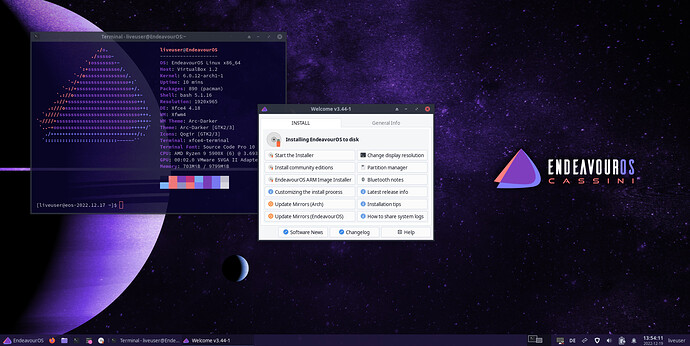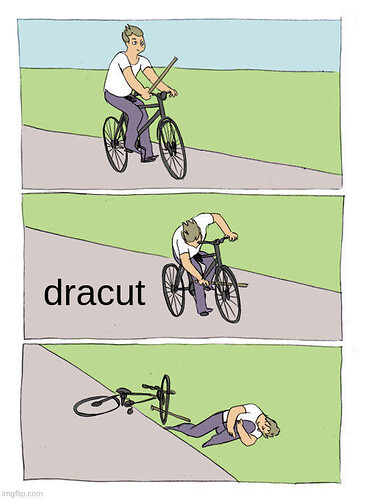Image by Rockwallaby
It took the development team on a longer journey than expected but we are proud to present you our latest Cassini release, named after the Nasa mission with the Cassini spacecraft carrying the Huygens probe.
Just like the Nasa mission that had its fair share of nail-biting moments, this release had some nail-biting test runs because getting here required a major overhaul in how we build our ISO. The last time we presented such a major overhaul was our ISO-Next release back in August 2021.
Cassini
Wallpaper by Rockwallaby
I know that most of you already know, but better be safe than sorry, if you already have EndeavourOS up and running, you don’t have to reinstall the system. We are a rolling release and you already have the latest updates if you recently updated the system. For certain new features we have brand new Discovery articles to help you further but I’ll come back to those a little bit later.
This ISO and the offline install comes with:
- Calamares 3.3.0-alpha3
- Firefox 108.0.1-1
- Linux kernel 6.0.12.arch1-1
- Mesa 22.3.1-1
- Xorg-Server 21.1.5-1
- nvidia-dkms 525.60.11-1
- Grub 2:2.06.r403.g7259d55ff-1
And it ships with these new features:
x86_64:
- Added a choice of bootloaders as well as the ability to not install a bootloader (systemd-boot is default selected)
- Switched to dracut from mkinitcpio
- Added an entry for Windows when using grub or systemd-boot and Windows is installed
- You can now choose to create a new EFI partition instead of re-using the existing one when using “Replace partition” or “Install alongside“.
- Grub submenu feature is now enabled by default (only default entry is visible extra entries are inside a submenu)
- Default wallpaper/background is now set by settings packages instead of welcome
- KDE/Plasma: Replaced the discover icon with a Konsole icon.
- Cinnamon: Replaced adwaita icons with Qogir
- GNOME: uses Console and Gnome-text-editor instead of now legacy gedit and gnome-terminal, Wallpaper follows night and day theme same for Console (it is set to dark only by upstream default)
- Budgie: is set to Qogir Icons and arc GTK theme and uses Nemo instead of Nautilus (to have even theming possible, Nautilus is not able to get theming from Budgie)
- Lots of Calamares cleanup work
- Reorganized and cleaned up the netinstall packages
As you can read on top of the list, we now offer the options to install the system without a bootloader, systemd boot or GRUB. This will enhance the experience to install a system to your liking from step one.
We now also install the system with Dracut, a highly modular tool for generating initramfs images, instead of mkinitcpio by default. In general, it is superior to mkinitcpio in it’s ability to autodetect needed modules and for most use cases will work without any further configuration.
For users who already have EndeavourOS up and running but also want to switch to Dracut or switch to systemd-boot, a manual is in the making. If you want to read more on Dracut or systemd boot, it can be read over here:
https://discovery.endeavouros.com/installation/systemd-boot/2022/12/
https://discovery.endeavouros.com/installation/dracut/2022/12/
ARM
Wallpaper by Rockwallaby
EndeavourOS ARM also comes with new features
- EndeavourOS Arm now supports Pinebook Pro.
- New
linux-eos-armkernel withamdgpuintroduced for more generic Arm device support including pinebook pro. linux-eos-armships withamdgpumodule prebuilt for supporting devices like Phytiuim D2000.- Raspberry Pi Imager/dd compatible images available for download. Improves accessibility of arm i.e. users from any OS can flash eos-arm to their arm SBC
- Improved headless server script.
- Odroid N2+:
vulkan-panfrostandvulkan-mesa-layersinstalled to reduce artifacts on plasma x11 sessions and improve overall graphics performance and stability.
From now on the Pinebook Pro is officially supported by us.
For hardware and driver support for Pinebook Pro we ship the following packages:
- linux-eos-arm
- libdrm-pinebookpro
- pinebookpro-audio
- pinebookpro-post-install
- ap6256-firmware
- towboot-pinebook-pro
We’ve leveraged existing work and PKGBUIDs of both Manjaro ARM and archlinuxarm-pbp projects to create our Pinebook Pro images and would like to thank them for their continuing work in supporting PineBook Pro for Arch Linux ARM platform.
Thanks
As you can read, with this release some big milestone steps were taken to go forward into the future. I really would like to thank the entire development team and our ISO test group for their perseverance in making this release possible. I know there were some painstaking and frustrating moments along the way, but you kept on going, moving huge mountains. You really deserve all credit for this release.
We hope you will enjoy Cassini and to download the ISO, just visit our download page. It is available in the list underneath the release notes.




